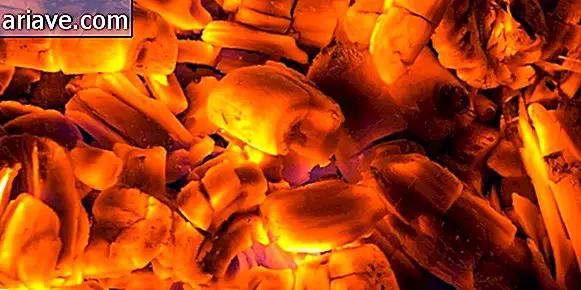Fake cancer? 7 Facts You Didn't Know About Tattooing
Tattoos have become common over time. But what we don't know is that they can be used as medical instructions (although not recommended), or that some inks can cause problems if you need an MRI, among other weird facts.
Check out a list of seven bizarre curiosities surrounding the tattoo world:
7. The QR code incident
Fanatical fans eternalize their passion in the skin by drawing flags, shields and players. But this year, a supporter of Argentina's River Plate chose a peculiar tattoo to show his love: a QR code that led to a YouTube video with images that glorified his heart club. But he made the mistake of sharing his tattoo on the internet. When fans of a rival team saw the post, they rallied to report the video, claiming that it was violating various copyright laws. Although that was not true, YouTube removed the video - and rendered the Argentine fan's tattoo useless.

(Source: Press Release / Listverse)
6. Fake Cancer
In 2017, when an unidentified patient discovered a lump in each armpit, she became concerned. It was a classic symptom of a cancer called lymphoma. The Australian woman underwent surgery to remove a sample for analysis. Earlier, the medical team had noticed that the 30-year-old patient had no other symptoms of lymphoma, such as sweating, weight loss or itching.
When they examined the lymph node, it was clear why. It was not cancer. Instead, a similar reaction was triggered by a tattoo made 15 years ago. The lump was full of immune cells that consumed the black pigments as if they were a threat. Several cases prior to this also reported the link between tattoos, fake lymphoma and melanoma.

(Source: Press Release / Pixabay)
5. "Do not resurrect"
In 2017, a 70-year-old man left his nursing home, got drunk and passed out on the streets of Miami. He was rushed to the Jackson Memorial Hospital emergency room, where doctors discovered the words "Do not resurrect" on the patient's chest. The "no" was underlined for emphasis and a close signature added more seriousness to the request. As the man was in critical condition, the tattoo caused concern.
The doctors didn't know how cool this request was and if they should comply with it. The man was unconscious, unidentified, and no friends or family could confirm the information. The message seemed pretty clear, but a few years ago another man with the same tattoo told doctors he wanted to be saved. He had been forced to tattoo the message after losing a bet on poker.
Fearing the same situation, the medical team decided to move on and keep him alive. Over the next few hours, the case was reviewed and the doctors talked to an ethics consultant who advised them to honor the tattoo of the patient who died the next morning. The man's documentation was found and confirmed his desires to die. However, while physicians act on the patient's wishes, ethics experts do not encourage this type of tattoo as they do not adequately replace official documents.

(Source: Press Release / Listverse)
4. Problems with MRI
Metal objects are not allowed inside an MRI machine as the device works with magnets. For this reason, patients should remove jewelry, accessories, glasses and even underwear containing metal. People with tattoos face a rare but serious risk, as some dyes contain metals, which can cause skin irritation.
A particularly painful incident occurred when a woman got into an MRI machine and came out with first-degree burns on her eyelids. She had permanent eye makeup. The researchers tracked the manufacturers of the paint used in this case. They admitted that the dye contained several heavy metals but no ferric oxide.
Ferric oxide is suspected of causing tattoos to get hot, causing burns. However, as tattoo ink is not regulated by the federal agency of the US Department of Health and Human Services, the FDA, the manufacturer may have omitted the presence of aggressive ingredients.

(Source: Press Release / Pixabay)
3. Tattooed Grasshoppers
Why not use tattoos on a grasshopper's wings to guide the insect to find explosives? The US Naval Research Office does not find the idea as absurd as it sounds. In 2016, the department gave scientists $ 750, 000 - the equivalent of more than $ 3 million - to research the technology.
The tattoo is not the traditional type, but made of biocompatible silk, acting as a heat conductor. When tattoos heat up on the insect's wings, it helps direct the insect to its desired location - such as a remote location or bombs. Moreover, no artificial sensor matches the insect's ability to detect a specific aroma among other smells.

(Source: Press Release / Listverse)
2. Tehran Secret Tattoo Artists
Tattoos are not accepted worldwide. In Tehran, Iran's capital, a tattoo artist must keep his work a secret. Not infrequently, the tattoo artist, when discovered by the government, is punished. Sentencing varies, but popular choices include whipping, fines or imprisonment. Public places also carry messages such as "If you have a tattoo, you're not welcome here." Despite this, Tehran has many tattoo artists and clients. For many, getting a tattoo is a form of resistance against a stifling culture where self-expression is not encouraged.

(Source: Press Release / Pixabay)
1. Inheritance Tattoos
One in five Americans has at least one tattoo. The tattoo industry in the United States is growing, stimulating the emergence of by-products. But in recent years, a strange fashion has emerged in the universe of tattoos. This is Save My Ink, a service that lets people frame their tattoos after death and give them to someone. Here's how it works: After the client dies, the company ships a funeral home kit that contains everything the team needs to remove the tattoos. The funeral home sends the material to the National Association for the Preservation of Skin Art (NAPSA), which preserves and frames the tattoos before handing them over to the deceased's loved ones.

(Source: Press Release / Listverse)











